Raw Food Living - Doing Raw Right
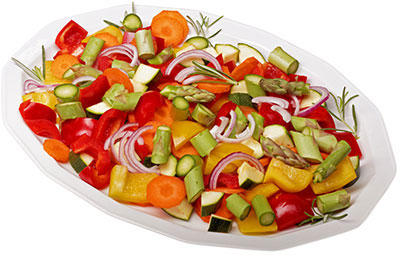 When it comes to a diet of raw foods, it is very important to take the time to understand how to do raw right.
When it comes to a diet of raw foods, it is very important to take the time to understand how to do raw right.
Just as with other diets and diet philosophies, if you do not educate yourself on how to eat the right food types in a balanced manner, then you can quickly get yourself into trouble. Many people who try raw living are not able to sustain it because of the 4 most common pitfalls (see below).
What Is A Raw Food Diet
There are many incorrect assumptions about what a raw food diet is (and they are often made by nutritionists and dietitians who are not educated on the subject). Read more about how a raw food diet is NOT a vegetarian or vegan diet unless you choose for it to be. In fact, raw cheese is a very common food in raw food living, as is sushi. Also, raw food living is about eating a diet that is predominantly raw food - over 75% - not "militantly" adhering to 100% raw unless that is your personal choice.
Learn about raw food living...
On a raw food diet, your eating habits will change drastically. This is an extremely nutrient dense diet with health benefits that cannot be surpassed by any other diet. It is used by clinics to treat terminally ill patients and restore them back to health, and in many cases has the power to restore the body from serious chronic diseases.
Doing raw right is not complicated. You just need the right tools, know how to transition, avoid the common pitfalls, and supplement ONLY if necessary.
Are you ready to explore raw food living? Great! Then let's get started...
Raw Food Kitchen Tools
 Living the raw food lifestyle can be as easy or as time consuming as you like. Because of the lack of cooking, many raw food dishes are easy to prepare (think chopped salads, whole fruits, avocado/sprouts/raw cheese wraps, smoothies, and fresh juices). The statement some people make that "food prep time is totally impractical" are made by those who are ignorant and uneducated about raw food living.
Living the raw food lifestyle can be as easy or as time consuming as you like. Because of the lack of cooking, many raw food dishes are easy to prepare (think chopped salads, whole fruits, avocado/sprouts/raw cheese wraps, smoothies, and fresh juices). The statement some people make that "food prep time is totally impractical" are made by those who are ignorant and uneducated about raw food living.
Those who like more variety and have the time, dehydrate, sprout, or ferment foods. Even though this can be more time-consuming, it is done in bulk and the foods last for an extended period of time.
For those who enjoy cooking, "uncooking" gourmet meals can turn into a very exciting and creative experience. All it takes is a little education to understand that the most incredible salad dressings can be made from blending just a few raw food ingredients, and that raw food desserts can taste so amazing that they easily surpass the tastiest piece of cheesecake or mouth-watering cake you have ever eaten. The best slice of birthday cake I have ever had in my life was at a raw food retreat in Colorado, where a gourmet chef prepared a dessert that literally put me into a state of ecstasy! Never would I have believed this was a raw dessert if I had not witnessed it being made myself.
Let's take a look at a few kitchen supplies you will need:
Chopping Essentials
A chopping board and a high quality, sharp knife is a must to slice and dice veggies, especially some of the denser ones such as beets, winter squashes, and jicama, and the ones with dense outer skins such as pineapples.
Blender/Food Processor
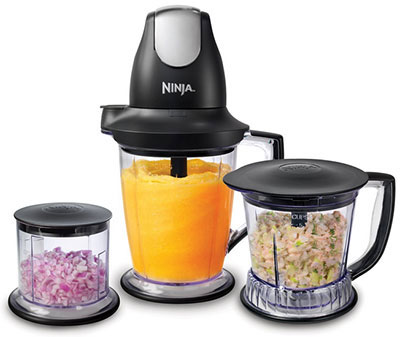 These are used to blends fruits and vegetables into smoothies, and to also make purees. Some can also turn nuts into nut butter. Some also act as a food processor and can shred, pulverize, grind, and chop.
These are used to blends fruits and vegetables into smoothies, and to also make purees. Some can also turn nuts into nut butter. Some also act as a food processor and can shred, pulverize, grind, and chop.
There are many blenders on the market, some affordable and some very expensive. It is not at all necessary to spend $300+ on a top-of-the-line blender, but you do need something powerful enough to blend smoothly.
Breville, Vitamix, and Blendtec are great options, but they are pricey. One of my favorite affordable blenders is the Ninja food prep set, which contains a blender, and acts as a basic food processor for chopping or pureeing food - all for under $60! They make several different products, including a blender (pictured above), and "Master Prep Professional" (pictured right) that has various container sizes food processing.
Juicer
These are used primarily to make fresh fruit and veggie juices. These days, juicers are available from everywhere and range from $50 all the way up to $200+. Some do the basic juicing of fruits and veggies, whereas others can also juice wheatgrass. Let's take a look at the 3 most common types of juicers on the market:
- Most juicers available are "centrifugal juicers" which do the job quickly and efficiently. They have a wide spout to push the produce into, and process a lot of juice in a very short amount of time. Most are also easy to clean, and are more reasonably priced than masticating juicers.
- Masticating/cold press juicers chew up the produce to a greater degree, extracting more juice and fiber. Some can also grind nuts to make nut milks. Juicing leafy greens such as spinach in a centrifugal juicer will yield very little juice, whereas a masticating juicer will be able to break down the spinach more thoroughly and extract more juice. Juicing using a masticating juicer is a much slower process, but the yield is greater. They can be very pricey.
- Wheatgrass juicers are made exclusively for extracting juice from wheatgrass and other leafy greens. Some masticating juicers can also juice wheatgrass.
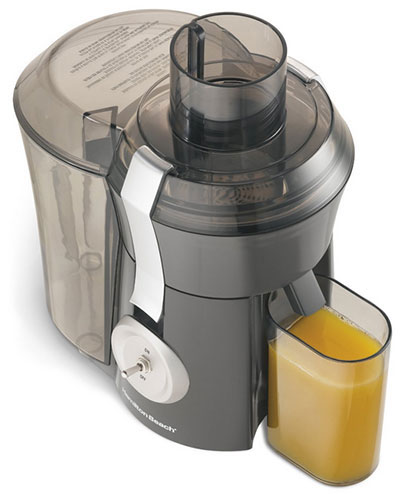 For those who do not like to spend a lot of time juicing (like me!), then a centrifugal juicer is for you. You may take a hit on the amount of juice extracted, but it is not a very significant amount and the time-saving factor can be significant. At a recent raw food retreat, I used their Champion brand juicer. And while I could absolutely appreciate the greater degree of juice extracted, not only did I have to cut up my veggies and fruits into much smaller pieces to fit them into the opening, but the machine itself was much slower at juicing than my centrifugal juicer. Making my juice took at least 2-3 times longer!
For those who do not like to spend a lot of time juicing (like me!), then a centrifugal juicer is for you. You may take a hit on the amount of juice extracted, but it is not a very significant amount and the time-saving factor can be significant. At a recent raw food retreat, I used their Champion brand juicer. And while I could absolutely appreciate the greater degree of juice extracted, not only did I have to cut up my veggies and fruits into much smaller pieces to fit them into the opening, but the machine itself was much slower at juicing than my centrifugal juicer. Making my juice took at least 2-3 times longer!
For me, the time-saving factor with my centrifugal juicer was the deciding point. I have owned several juicer brands, from Jack Lalane to Breville to Hamilton Beach. My favorite is my Hamilton Beach Big Mouth Pro - to top it off, it's only $60 on Amazon. I can chop, juice, and clean the juicer in under 5 minutes.
Spiralizer (optional, but recommended)
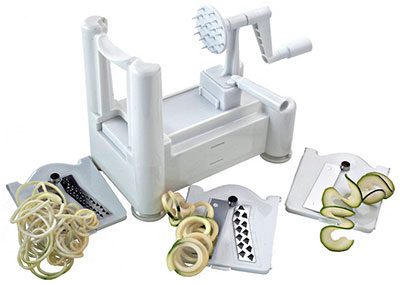 This is not only a fun kitchen tool, but it is also easy to use and very inexpensive - under $40!
This is not only a fun kitchen tool, but it is also easy to use and very inexpensive - under $40!
A spiralizer quickly turns all your favorite veggies into long strands of "veggie pasta" that can then be mixed with your favorite sauces (pesto and marinara anyone?). Common veggies to spiralize include zucchini, carrots, beets, and jicama.
My favorite is the Paderno spiralizer, which comes with 3 different blades to make different sized spirals, and is made from BPA-free plastic that simply suctions to your counter. It is very easy to use, does the job quickly, and the chopping blades pop right into your dishwasher. Best of all, it is far lighter and healthier than a plate full of heavy grain-based pasta.
Dehydrator (optional)
Although fresh food is always best, dehydrating foods offers more variety in terms of taste textures and types of snacks. Foods commonly dehydrated are fruits, veggies, nuts/seeds, and a mixture of different raw foods pureed and then spread out on dehydrating trays to create crackers and wraps. Dried fruits can be eaten as snacks, or they can be soaked and blended into various desserts and smoothies.
 Depending on how long you dehydrate for, the food can be crunchy, crispy, or chewy. You can also create the semblance of "marinated veggies" by mixing them in your favorite sauce and reducing the typical dehydrating time. For example, slicing up button mushrooms and tossing them in nama shoyu (unpasteurized soy sauce), or mixing with nutritional yeast and apple cider vinegar before dehydrating for 2 hours gives the mushrooms a lovely marinated and juicy texture.
Depending on how long you dehydrate for, the food can be crunchy, crispy, or chewy. You can also create the semblance of "marinated veggies" by mixing them in your favorite sauce and reducing the typical dehydrating time. For example, slicing up button mushrooms and tossing them in nama shoyu (unpasteurized soy sauce), or mixing with nutritional yeast and apple cider vinegar before dehydrating for 2 hours gives the mushrooms a lovely marinated and juicy texture.
There are several different brands of dehydrators on the market that offer varying temperatures and options (such as a built-in timer) to dehydrate foods. They are either square or round, and work by slowly drying foods at very low temperatures. The most popular brand is the Excalibur, which is available with either 4 trays, 5 trays, or 9 trays.
Even though dehydrators can be on the expensive side, they are workhorses that can prepare a large amount of food at one time. Some raw foodists consider it indispensable, whereas others do not use them at all. The drawback of food dehydration is that it can take a long time, with time frames for some foods often in excess of 20 hours. This means that if you are dehydrating foods for a gathering or party, advance planning is required.
Sprouting Jars (optional)
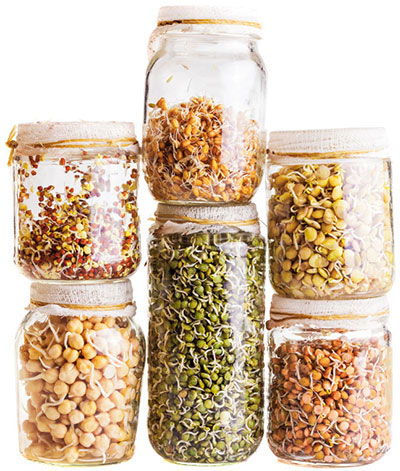 Sprouting at home is optional, but it is so easy and fun to learn that it is well worth it! Sprouts are considered superfoods because they are packed with nutrition such as high quality protein and protective compounds. All you need are some mason jars, 3% hydrogen peroxide, and a selection of organic seeds for sprouting.
Sprouting at home is optional, but it is so easy and fun to learn that it is well worth it! Sprouts are considered superfoods because they are packed with nutrition such as high quality protein and protective compounds. All you need are some mason jars, 3% hydrogen peroxide, and a selection of organic seeds for sprouting.
Learn about:
- The different types of seeds available.
- How to sprout seed, including legumes.
- Food safety & sprouting
Easing Into the Raw Food Lifestyle
For many people, transitioning to a diet of raw foods can be very challenging, especially if attempting an "all-or-nothing" approach. Easing into it is very important so that you can give your body the time it needs to adjust. There is no rule that says you should rigidly adhere to 100% raw, and I do not recommend it. A predominantly raw diet, with the addition of some lightly cooked foods is not only perfectly acceptable, it is the best and healthiest way to go. There are some vegetables that should NOT be eaten raw as the cooking process makes them much more digestible.
Here are 10 important tips to help smooth the pathway to raw living:
- Ease into it
It can be difficult in the beginning to adjust to a raw food diet cold turkey. Making some simple transitional steps can help ease you into it:
- Choose one meal a day that is 100% raw, such as a breakfast filled with a variety of fresh, raw fruits, or a fruit smoothie with a handful of leafy greens such as kale or spinach.
- At each meal, aim to have at least 50% of the meal as raw, for example, a large, mixed salad.
- Use the crowding out philosophy. Each week, aim to increase the amount of raw foods, while slowly decreasing the amount of cooked foods. 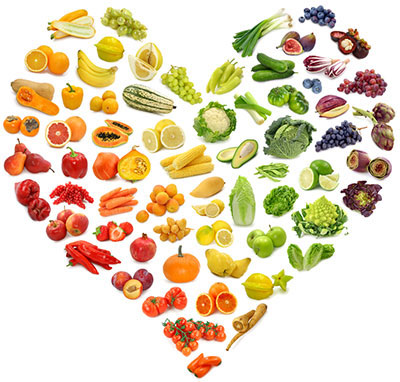 Pick rainbow foods
Pick rainbow foods
Build your food foundation on fresh, colorful fruits and vegetables that are the most nutrient-dense foods on earth. These foods are filled with antioxidants that help cleanse and detoxify the cells and tissues of the body.
Enjoy a wide variety of colors that are especially high in antioxidant value, such as:
Purples (Eggplant, beets, blueberries, blackberries, figs)
Reds (Tomatoes, bell peppers, strawberries, raspberries)
Yellows (Lemons, bell peppers, tomatoes, pineapple, banana)
Greens (All the leafy greens, including lettuce, kale, Swiss chard, cabbage)
Oranges (Bell peppers, apricots, oranges, tomatoes, peaches, pumpkin, carrots)
Learn more about the power of antioxidants and other anti-inflammatory foods in the Body Healer protocol.- Prepare the same foods differently
Look for different ways to make the same food. For example, a zucchini can be either chopped, spiralized into "pasta," or shredded and then mixed with a raw pesto sauce. It can also be added to a fruit/veggie smoothie or juice, or sliced and mixed with your favorite seasonings and dehydrated for 2 hours for a "marinated" taste. - Moderate fatty food intake
Fatty foods such as avocados, olives, raw nuts, and seeds provide protein, essential fatty acids, and trace minerals. But they should never be eaten in excess. Aim for 10% of your diet (a small handful of nuts, or a 1/2 avocado) each day to contain these yummy foods. Eat high fat raw food desserts in small quantities.
Avoid adding liquid fats to your foods unless in very, very small quantities - it is completely unnecessary. Liquid flax seed, coconut, or other oils are fractionated products that have been extracted from their original whole food and what remains is 100% pure fat. These fats may be healthy, but they will not have the same impact on the body as they would have as part of their original whole food, and it is easy to overeat them, so limit your intake of these extracted fats. - Choose sprouted grains over non-sprouted grains
Consider eating sprouted grains and legumes such as kamut, spelt, and rye, which can be sprouted and added to salads. Pseudo grains such as quinoa and buckwheat can also be sprouted. Wild rice can be "bloomed" in a dehydrator. Sprouted grains and legumes are nutritious foods that contain protein, iron, zinc, and other trace minerals. - Soak nuts & seeds before eating them
Soaking raw nuts and seeds overnight improves their digestibility, as the soaking helps to activate their enzymes, and deactivate enzyme inhibitors. - Adjust to how the weather makes you feel
Raw foods have an inherently cooling effect on the body, which can make it a difficult diet to sustain in colder climates and in winter months. Include more lightly cooked vegetables and sprouted grains during this time. - Supplement ONLY if needed
Only take supplements if you are found to be deficient, rather than simply taking them because you think you "may" need them. On a healthy diet, your need for supplements should be close to zero. Having said that, the two common deficiencies are vitamin B12 and/or Vitamin D3. Take them only if a test reveals you are deficient, and then stop taking them when optimal levels have been restored. Diet that recommends supplements on a daily basis often do so because they are nutritionally deficient. - Some foods should be cooked
There are certain foods which, once cooked, are much more easily digestible. Cooking helps break down plant cell walls in some vegetables to increase their nutrient availability. These foods include cooked beans, legumes, and some dense veggies. When cooking vegetables, lightly steam or boil them in stainless steel and serve while they are still crunchy. If boiled, make sure that you use the cooking water as it is filled with minerals leached from the foods (or mix it in with your pups food for a nutritional boost!). - Avoid talking about raw foods with those not interested
Refrain from discussing your diet with people who have no interested in raw foods, or who are intent on convincing you that a raw food lifestyle is not a healthy one. It is a very healthy diet when approached correctly. Countless individuals have recovered from chronic and debilitating diseases living the raw food lifestyle, and no studies have proven that fruits, vegetables, nuts, seeds, and sprouted grains are "bad for our health." On the contrary, the standard American diet is the quickest path to chronic disease that you will find.
Check out our recipes section where you'll find a great selection of salads, appetizers, dips, and desserts that are 100% raw!
Avoid the 4 Most Common Pitfalls
Many people who begin a raw food diet find it very difficult, and quickly give up. Others eat an unhealthy version of the diet and end up suffering from some of the same health consequences as those on an unhealthy processed and refined diet, due to a lack of education on how to successfully eat raw foods. Many put on weight due to the high-fat content.
If you are ready to take the leap into raw food living, here are the 4 biggest pitfalls to watch out for:
Supplement Only If Necessary
By giving your body a continuous supply of raw foods in your diet, you will have a far superior nutritional advantage. If done correctly, a healthy raw food diet filled with at least 75% antioxidant and nutrient rich fruits and vegetables should require little to no supplementation, especially when organic.
Do not fall for the hype preached by any raw food websites, or raw food guru that tell you to pop an array of expensive supplements and powders. You will quickly go broke on your way to getting healthy, and it is completely unnecessary. Come cleanses and detox diets are notorious for requiring supplements (often their own brand) with the claim these supplements are necessary. They are not. Like liquid oils, supplements are fractionated products where specific nutrients have been extracted. Many are also synthetic and have a different biological impact on the body as compared to their natural counterpart.
A diet, cleanse, or detox that requires supplements
is a diet that does so because it is nutritionally deficient
Having said that, there are two notable exceptions:
Vitamin B12
Vitamin B12 comes from bacteria from the food we eat, and is produced internally by our bodies. It is also efficiently recycled in the body and can last over 2 years in a healthy adult without requiring direct dietary sources. But in this day and age, with the depletion of our soils and the pollution of our planet, non-organic plant foods are no longer considered a reliable source of B12. A deficiency is now common in meat eaters, vegetarians, vegans, and raw foodists alike, but more common in vegans.
Although many raw foodists receive plenty of vitamin B12 from a raw diet (more so with organic foods where this nutrient has not been destroyed by pesticides), studies consistently demonstrate that raw food vegans are more deficient in B12. The recommended levels are >400pg/ml, with raw vegans averaging <100-200pg/ml.
Vitamin D
Depending on the climate you live in and how much year-round sunlight you are exposed to, vitamin D supplementation may be required. Vitamin D is a common deficiency, especially in northern countries such as Canada, the northern US, and northern Europe. The continual application of sunscreen can also block vitamin D absorption and cause a deficiency, even for those living in sunnier climates. Studies are also finding that the toxic chemicals in these sunscreens are far more likely to contribute to skin cancer than the sun itself.
Studies have shown that Vitamin D is just as effective,
if not more so, than the controversial flu vaccine.
When it comes to supplements, avoid self-diagnosing. If your diet is varied and healthy, you should never need to take daily supplements, especially multi-vitamins. Instead, monitor your levels of these nutrients in your body by taking a simply yearly test, and ONLY take supplementation if you are deficient. Otherwise, they are a waste of your money. At best, high quality supplements should be used only to help resolve a health issue, and then be discontinued when they are no longer needed.
Make sure the supplements you choose are from whole foods, and from a reputable manufacturer (preferably in raw form). There are several very commonly manufactured synthetic supplements such as folic acid and vitamin A that have been conclusively shown in health studies to be damaging to your health.
 Explore the Body Healer Protocol to learn about:
Explore the Body Healer Protocol to learn about:- Vitamin B12 & the best sources
- Vitamin D for health & flu prevention
- Why supplements are not the holy grail
- Why you should avoid common synthetic supplements




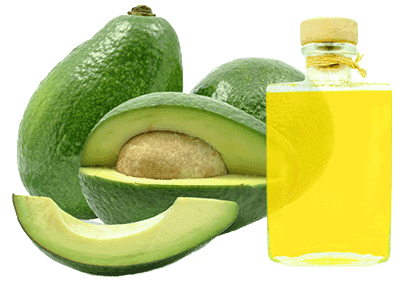 When people begin incorporating more fruits and vegetables into their diet and begin eliminating processed foods, the first thing that usually happens is they gravitate towards food similar to what have been removed (i.e. dense, heavy foods). They excitedly fill their diets with new-found delights, such as:
When people begin incorporating more fruits and vegetables into their diet and begin eliminating processed foods, the first thing that usually happens is they gravitate towards food similar to what have been removed (i.e. dense, heavy foods). They excitedly fill their diets with new-found delights, such as: